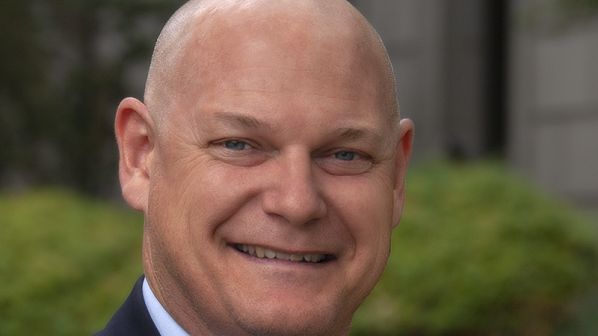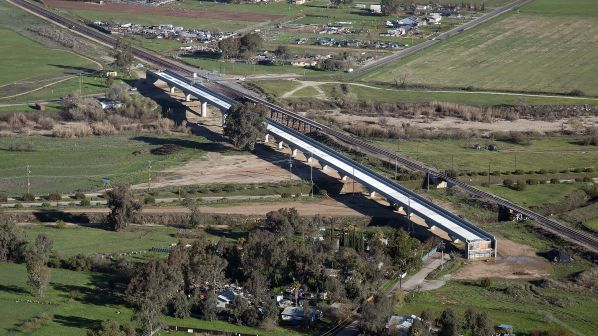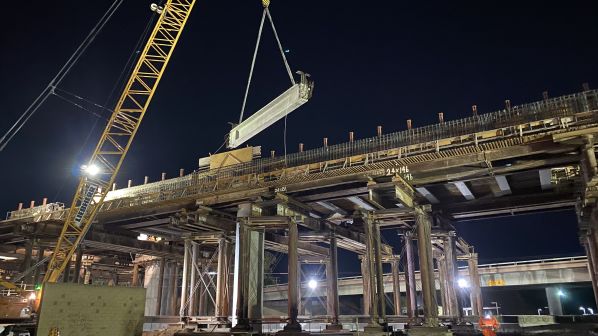CALIFORNIA has long been a promotor of initiatives to reduce pollution in the state, and building an electric high-speed railway to connect the main centres of population was seen as an important step on the road to improving the environment by encouraging people to switch from gas-guzzling cars and aircraft to trains. High-speed rail was also seen as a way to avoid investing in more highways and expanding airports.
California High-Speed Rail Authority (CHSRA), which was set up in 1996, drew up plans to build a 1290km network connecting San Francisco with Los Angeles and Anaheim, with extensions to Sacramento and San Diego following in a second phase. The goal was to have the full system in place by 2030.
With trains reaching 350km/h on new-build sections, a San Francisco - Los Angeles journey time of 2h 40min was envisaged. Traffic was estimated at 90 million trips per year, and the project was expected to generate $US 150bn in measurable present-value benefits during the next 40 years. The plan was approved by Californian voters in 2008. The so-called Proposition 1A provided $US 9bn to launch the project which was estimated to cost $US 45bn to complete.
Construction started in 2015 on the initial 191km section in the Central Valley between Madera, Fresno and Bakersfield, but progress was slow. CHSRA reported a $US 5.5bn reduction in the projected cost for the entire scheme in 2016, mainly through value engineering efforts, a better approach to design, and a favourable bidding environment.
Unfortunately, that achievement was short lived, and costs soon started to mount. In CHSRA’s 2018 Business Plan the estimated cost of the initial section had risen to $US 10.6bn while the cost of completing Phase 1 from San Francisco to Los Angeles and Anaheim had jumped from an estimate of $US 64.2bn in 2016 to $US 77.3bn with a later completion date of 2033. CHSRA also recognised that the final bill could reach $98.1bn in its worst-case scenario.
Faced with mounting criticism, not least from the White House, the new governor of California, Mr Gavin Newsom, announced in February 2019, one month after taking office, that the high-speed rail project would be scaled back due to what he described as spiralling costs and poor oversight - only the section currently under construction in the Central Valley would be completed.
“Our estimate right now is that we are about halfway through that Central Valley project, and really starting to pick up pace”
Brian Kelly, CHSRA's CEO
“Let’s level about high-speed rail,” Newsom told the California legislature in his first state of the state address. “I have nothing but respect for governor Brown’s and governor Schwarzenegger’s ambitious vision. I share it. And there’s no doubt that our state’s economy and quality of life depend on improving transportation. But let’s be real. The current project, as planned, would cost too much and respectfully take too long. There’s been too little oversight and not enough transparency.”
Nevertheless, Newsom confirmed that the Central Valley section would be completed. “For those who want to walk away: abandoning high-speed rail means we will have wasted billions of dollars with nothing but broken promises and lawsuits to show for it,” he said.
Defiance
Newsom’s determination to complete the first section was in defiance of the Trump administration’s opposition to the project. Indeed, the US Department of Transportation (USDOT) announced that the Federal Railroad Administration (FRA) would cancel federal grants awarded to the project.
“The federal government under the Obama administration committed $US 3.5bn to this project,” CHSRA’s CEO, Mr Brian Kelly, explained to IRJ on October 20. “We have spent $US 2.bn of that, and our requirement is to match that dollar per dollar. We have now matched about 80% and we will meet that full match in early 2021.

“The Trump administration made a move to take back $US 920m in March 2019. We protested and took the Trump administration to court and we are still litigating that. It was a move that was made without any process at all.” As Kelly observed, the federal government is trying to reclaim the money essentially because president Trump doesn’t like the project.
Eighteen months later the picture is starting to look a little different. The draft 2020 business plan says that by 2040, the system should be carrying 40 million passengers and generating $US 4.5bn in farebox revenue each year, which CHSRA says will easily cover operating costs. CHSRA also predicts $US 131bn in economic output.
“The project is progressing very well, especially considering the impacts of the Covid-19 pandemic this year,” Kelly says. “We have had to quarantine workers from time-to-time, but notwithstanding that we have been able to expand our construction sites. We are way up on construction and the number of workers that we have dispatched out to the job sites has quadrupled over the course of the last 18 months.
“About a year ago, we were spending about $US 20m a month on construction, and now we are spending upwards of $US 100m per month.” In addition, Kelly says all the environmental review documents covering the entire route from San Francisco to Los Angeles have been cleared.
“Our estimate right now is that we are about halfway through that Central Valley project, and really starting to pick up pace,” Kelly says. “We are looking forward to finishing it in the next 24 months or so. Our objective is to have a track down and systems in place, and essentially be able to test high speed electric trains.” Kelly thinks two high-speed trains should be sufficient to conduct testing, and a decision on how to acquire them will be made by the end of next year.

“Our next step is to find the best early operational segment,” Kelly explains. “We want to extend that 191km to about 275km and connect the three major cities in the Central Valley.” These are Bakersfield, Fresno and Merced which have a combined population of about 3 million people.
CHSRA is undertaking a ridership review of the extended section, which should be ready in a couple of months. CHSRA also secured the final environmental impact statement for the Central Valley Wye in September. This comprises an 80km extension of the initial Central Valley section north from Madera to Merced, including the Y junction for the new line to Gilroy. “We can now proceed with the next step in pre-construction activity,” he says. “We can extend out the design work from 15% to something more like 50 or 60%.”
When the extension is completed, Merced will become a hub with cross-platform interchange to Amtrak services to Stockton, Sacramento and Oakland, and possibly ACE commuter rail trains to Silicon Valley and San Jose. “It’s really an interim solution,” Kelly admits, but even with a change of train, there will be significant journey time savings, as the Bakersfield - Merced trip will take just 90 minutes by high-speed train compared with more than 3 hours by Amtrak today.
CHSRA will not operate the high-speed railway. The San Joaquin Joint Powers Authority, which is responsible for managing Amtrak’s San Joaquin service linking Oakland and Sacramento with Bakersfield, will be responsible for finding an operator which would lease the assets from CHSRA. “We are executing a memorandum of understanding (MoU) with the San Joaquin Joint Powers Authority now that outlines roles and responsibilities, including ensuring things like payments which would cover our maintenance costs,” Kelly says.
Budget
So far, around $US 7.5bn has been spent on construction in the Central Valley, and all the state-wide environmental work CHSRA is doing. It also includes investments made in so-called bookend projects. These include the $US 713m electrification of the Caltrain line between San Francisco and San Jose, upgrading the Burbank - Los Angeles Anaheim line, and a scheme to convert Los Angeles Union from a dead-end to a through station.
CHSRA estimates it will need another $US 21bn to complete the 275km section from Merced to Bakersfield. “In addition to the bond dollars the state of California passed back in 2008, we get what’s called cap and trade dollars, which are funds that come in annually in California through an auction process,” Kelly explains. “We estimate we have between $US 20.5bn and $US 23bn over the next 10 years. That budget excludes any additional federal funds.
“In the face of Covid-19, we have undertaken a very detailed risk assessment of where we are on cost, schedule, scope and revenues. We will be talking to our board in November about exactly where we stand, so there could be some moves that we have to make.”
“The project is progressing very well, especially considering the impacts of the Covid-19 pandemic this year,”
Brian Kelly
Despite the challenges the project has faced, and its bad press, there has been little change in attitudes to building the new railway. “Back in 2008, when the voters voted for the bond bill, they got 53% of the vote,” Kelly says. “Today, most polls still show that about 52 or 53% of the voters support building this and about 48 or 47% do not.
“I need to be clear about something,” Kelly says. “The vision for this project that California has supported, is a high-speed electric train that connects San Francisco to Los Angeles and Anaheim. And that is still the vision. However, the entirety of that system will probably cost between $US 80 and 90bn to get it all done - San Francisco all the way to LA and Anaheim - so we are going to need a lot more money. I want to get all segments as close to construction ready as possible.
“I’m trying to get there by getting early operational segments going, so that people can see, touch, feel and experience what electrified high-speed rail is. I’m not here simply to do Merced to Bakersfield - it’s what I can start with.
“For policymakers in California, it really comes down to this: was the vision to build a clean and fast high-speed train service between San Francisco and LA the right vision? Is this the kind of investment we want to make in transportation? Do we want to continue to have passenger rail that takes 12 hours between those two cities, or do we want to do it in less than three? I think we want to do it in less than three and have transportation systems that do not pollute diesel. In the era of climate change, I think most policymakers would say these are the things we need to do, as difficult as they are.”
CHSR phase one development continues
PHASE one will involve the construction of a dedicated high-speed line from Gilroy to Merced, Fresno, Bakersfield, Palmdale, and Burbank. The maximum speed in the Central Valley will be 350km/h as far south as Bakersfield. However, the speed will be a bit lower in southern California through the Tehachapi mountains.
The tortuous section of existing railway through the Tehachapi mountains last saw a passenger train in 1971. “Today, freight trains take about two-and-a-half hours just to get up and over the mountain,” Kelly says.
The existing line from Palmdale, in the high desert, to Los Angeles is also a challenge for Metrolink commuter trains, which take two hours to complete the 110km trip. High-speed trains will cut this to around 30 minutes.
The section between Gilroy and San Jose will be rebuilt to provide two dedicated tracks for high-speed trains and a single track for freight services. North of San Jose to San Francisco and from Burbank to Los Angeles Union and Anaheim will involve upgrading and electrifying existing commuter lines, plus the construction of a new link to avoid trains having to reverse at Los Angeles Union station.
Palmdale could become a high-speed hub, if Brightline’s planned 270km 320km/h XpressWest line from Las Vegas to Victor Valley, northeast of Los Angeles, is extended west to Palmdale. “I think the biggest change for that project that really made it important for us, is that at one time it was going to be a 200km/h diesel-emitting service,” Kelly says. “However, now they have committed to a [320km/h] electrified railway, that is much more exciting from a California perspective. It integrates well with us, so I see Palmdale as the place where the two systems will integrate.”

